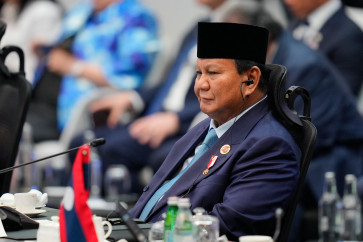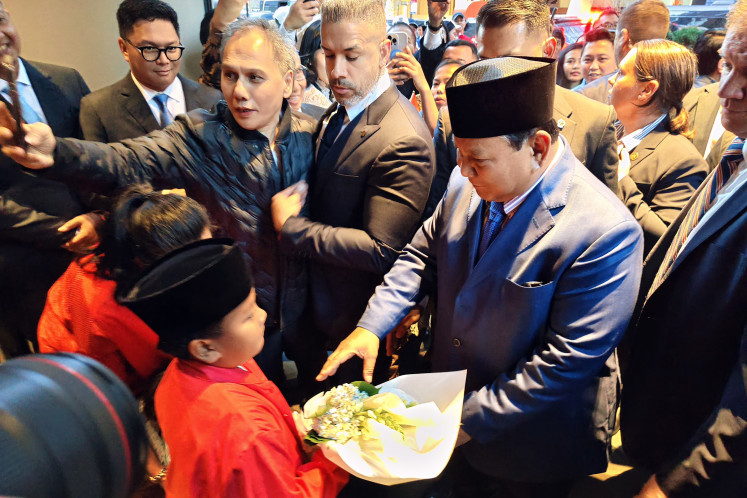Popular Reads
Top Results
Can't find what you're looking for?
View all search resultsPopular Reads
Top Results
Can't find what you're looking for?
View all search results'The Rose of Cikembang': The holy concubine
The Rose of Cikembang offers a glimpse into the intricate social issues during Dutch colonial times, wrapped in a tale as old as time itself: a tragic love story
Change text size
Gift Premium Articles
to Anyone
The Rose of Cikembang offers a glimpse into the intricate social issues during Dutch colonial times, wrapped in a tale as old as time itself: a tragic love story.
For those busy urbanites with little time for books, The Rose of Cikembang is the ultimate weekend read.
This short novel, tugging at emotions with the intrigues of love, lies and sacrifice, is a gem from a largely forgotten chapter of Indonesian literary history.
The book, published in 1927, tells the story of Chinese businessman Oh Ay Cheng, who was forced to part with his beloved Sundanese mistress (nyai) Marsiti in order to marry Lio Gwat Nio, whose father is a close business relation of the Oh family.
Marsiti voluntarily disappears from her lover's life to make way for his marriage, yet soon after dies of a broken heart after secretly giving birth to a daughter.
Although the marriage of Ay Cheng and Gwat Nio was harmonious, dark secrets continue to haunt their family and almost destroy them.
While the literal translation of nyai is concubine or mistress, in the context of Dutch colonial life in the Indonesian archipelago a century ago it refers to the indigenous lovers of European, Chinese or Arabic men. Their social status is delicate, as they rarely became their lovers' official spouse, even after the birth of children.
The novel suggests that the nyai were an integral part of life at that time. 'Almost all the employees and bosses of the plantation, Dutchmen or Chinese, keep their nyai in the kampong, even though they've got wives and children of their own,' says Ay Cheng's father as he tries to persuade his reluctant son to marry Gwat Nio.
Maya Sutedja-Liem, who translated Cikembang into Dutch, noted in the book's foreword that 'society looked scornfully upon this lifestyle (between nyais and their 'masters').'
However, she explained further, the Chinese Indonesian writers of that time painted a sympathetic picture of the nyai, as Kwee Tek Hoay did. 'I consider Marsiti higher than all of us. She is a pure spirit who came to this world with the purpose of sacrificing herself to you and me,' says Ay Cheng, describing his mistress to his wife.
With his agile pen, Kwee realistically portrays the social codes and morals of that era, while at same time making his own views on those matters crystal clear.
Kwee is critical of the views expressed by Ay Cheng's father, who pressures his son to part with Marsiti: 'So don't you give your heart away and be trapped by that kind of woman, least of all by Sundanese women. They've always had a reputation for casting black magic spells and getting your money, and they're famous for being the most unfaithful women in all of Indonesia.'
The story line disproves all of Mr. Oh's cliches, portraying Marsiti as loyal, compassionate and unmaterialistic.
Interesting is how the novel describes the position of the ideal woman of that time. Aside from being 'educated, kind-hearted and refined,' the most important thing for Gwat Nio is that she secures her husband's love.
'Why should I be offended and annoyed by you having kept a nyai for three years before we became engaged [...] I firmly believe that in the end I will win, just so long as I show that my love is greater and purer than all the women in this world who have loved Ay Cheng.'
Kwee's peranakan, or assimilated, Chinese background is reflected in the book with the presence of European, Chinese and Sundanese influences.
While Ay Cheng's son-in-law is a New York's Columbia University graduate, he also aspired to go to China, which was torn by a civil war at the time. Ay Cheng's family plays the piano and reads Irish poets. In case of illness, psychiatrists as well as the local dukun (witch doctor) are summoned.
Historically, the book is part of a largely forgotten yet important part of Indonesia's young literary existence. Chinese Indonesian writers such as Kwee wrote in Low Malay, which was the colloquial language already spoken for centuries as a lingua franca among the multi-ethnic Indonesian archipelago.
The writing is a fascinating coterie specked with Dutch, Chinese and ' depending on where the writer is from ' the local language such as Sundanese or Javanese.
George E. Fowler not only skillfully translated the novel, but in his introduction he wrote a historical and literary overview worth reading by itself.
'The Rose of Cikembang'
by Kwee Tek Hoay, translation by George E. Fowler.
Published by the Lontar Foundation, 2013.










